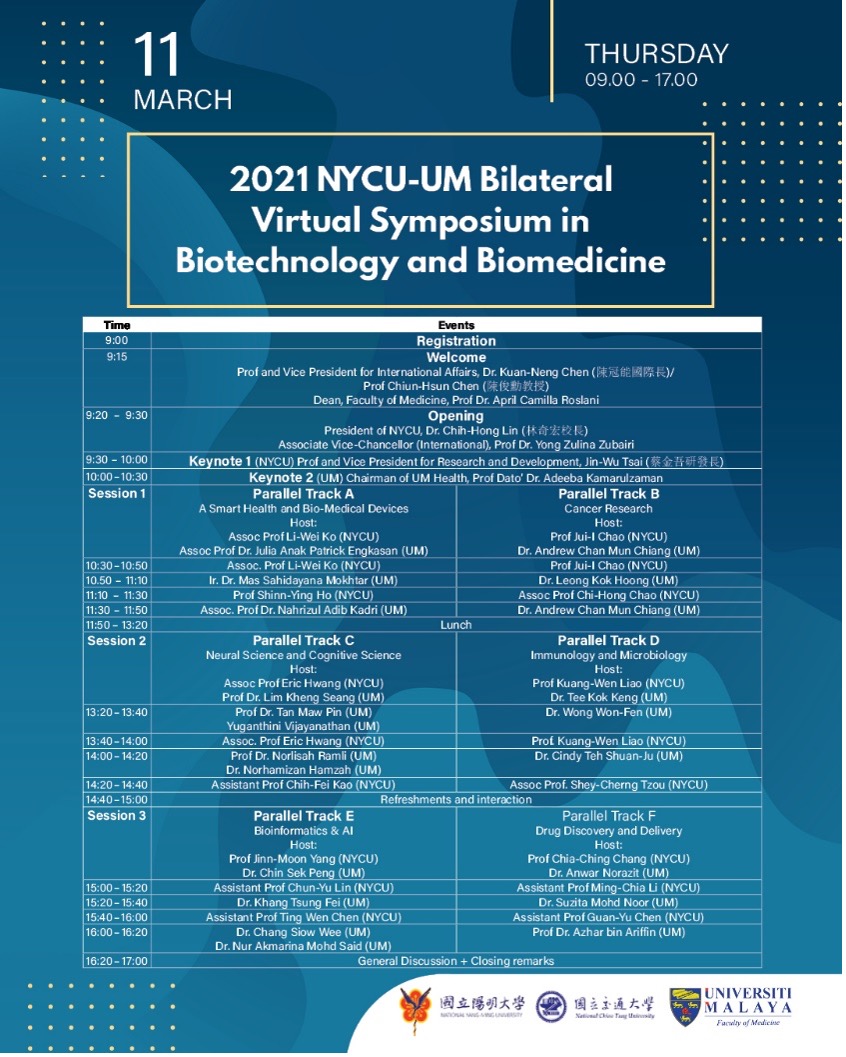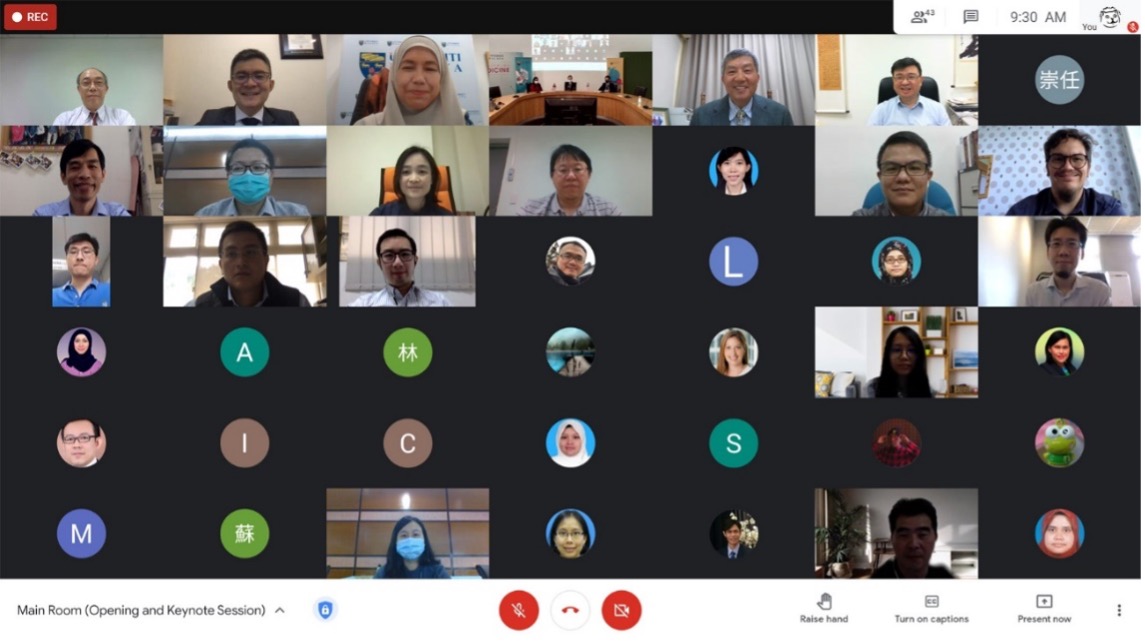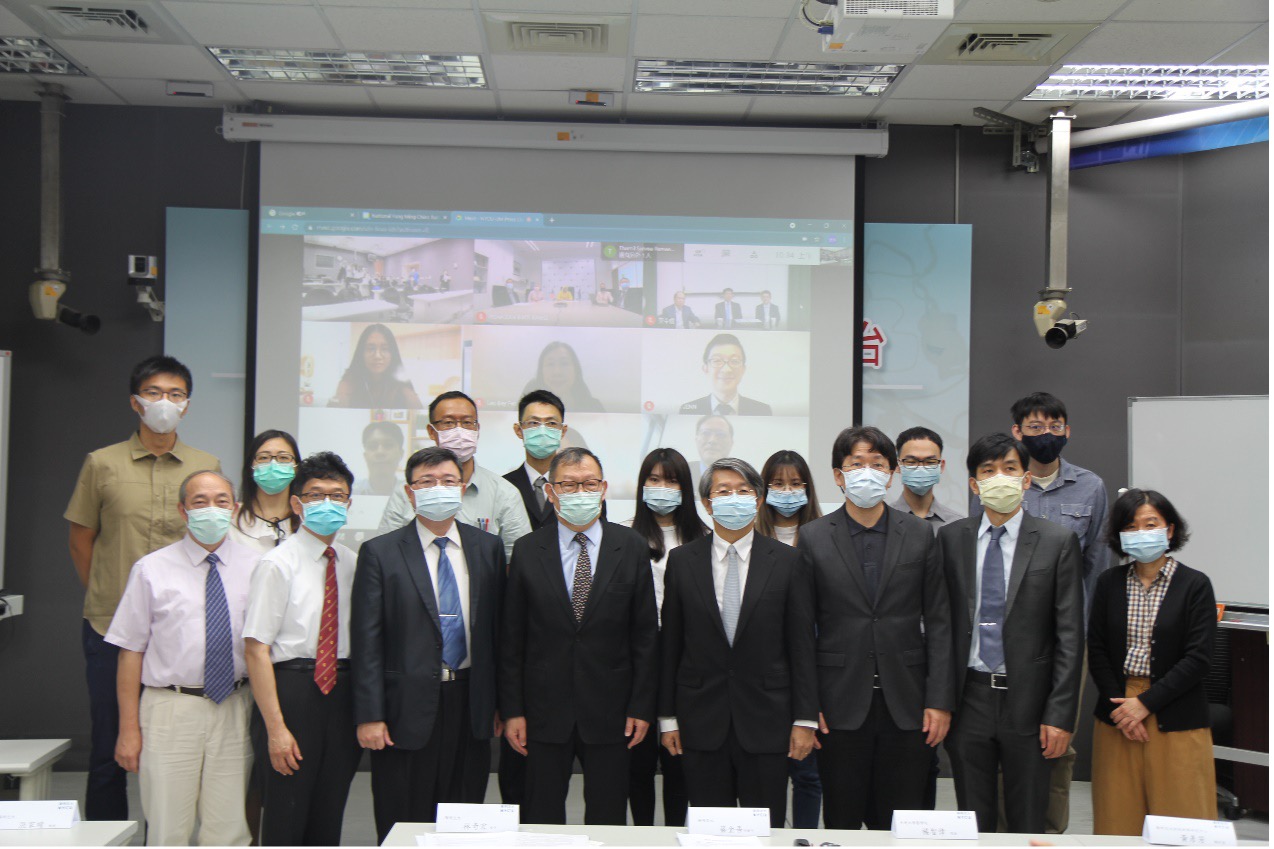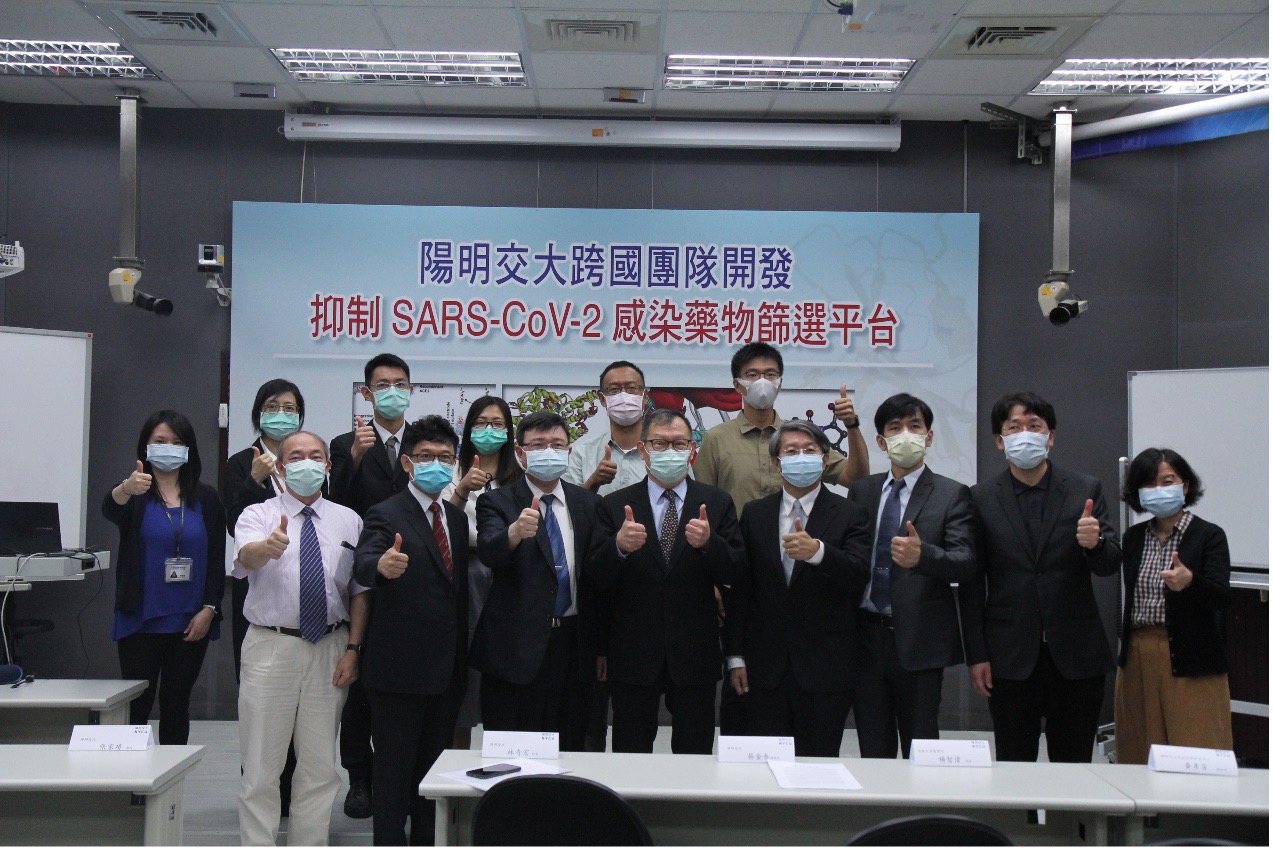National Yang Ming Chiao Tung University (NYCU) has been working with the Institute of Microengineering and Nanoelectronics and Institute of Science in Universiti Kebangsaan Malaysia (UKM) as well as the Faculty of Medicine and Faculty of Pharmacy in the University of Malaya (UM) in fields of semiconductor research and applications, biomedical science, drug control and release for many years. Under the guiding principle of the Ministry of Science and Technology (MOST) to promote academic and technological exchanges with the 18 New Southbound target countries, National Chiao Tung University established the Taiwan-Malaysia Semiconductor and Biomedical Oversea Science and Technology Innovation Center (NYCU) in September 2020. Based on the existing cooperation with the two top universities in Malaysia, the center aims to promote academic and technological cooperation between the three universities in Taiwan and Malaysia. Since the merger of National Chiao Tung University and National Yang Ming University in February 2021, the Center has become a platform for research, education, industry-academia collaboration, and innovative start-ups in the field of semiconductor and biomedical technologies between Taiwan and Malaysia. The collaboration will focus on novel electronic semiconductors, the biosensor and infectious disease detection system, new medicine development, medicine delivery system, cancer research, and bioengineering to create new research areas, applications, and industrial development, with the goal of promoting the development of Taiwan-Malaysia academia and industries as well as enhancing human welfare.
Since the beginning, the Center has been actively promoting academic exchanges between NYCU, UM, and UKM. For example, the Center has recruited many young scholars with expertise in biomedicine and biotechnology to form the Taiwan-Malaysia Academic Cooperation Group to match research teams and encourage researchers from both sides to cooperate and apply for multinational research projects.
To promote the exchanges and cooperation between scholars, students, and researchers from Taiwan and Malaysia, and to understand each other's research fields, the Center organized a virtual symposium called "2021 NYCU-UM Bilateral Virtual Symposium in Biotechnology and Biomedicine" (see Figure 1) in early March 2021, despite the COVID-19 pandemic. The symposium focused on smart medical and biomedical devices, neuroscience and cognitive science, biological information and artificial intelligence, new medicine development and medicine delivery system, cancer research, immunology, and microbiology to promote mutual understanding and enhance collaborative research.
Under the support of both universities, the symposium started with the opening remarks of NYCU former Vice President Chiun-Hsun Chen and Vice President for International Affairs Kuan-Neng Chen, and Dean of Research and Development Jin-Wu Tsai as the keynote speaker (see Figure 2). As for UM, Dean of the Faculty of Medicine April Camilla Roslani and Associate Vice Chancellor Yong Zulina Zubairi gave opening remarks for the symposium, and the International AIDS Society (IAS) President Adeeba Kamarulzaman was invited to give the keynote speech.

Figure 1: The poster of 2021 NYCU-UM Bilateral Virtual Symposium in Biotechnology and Biomedicine

Figure 2: The NYCU-UM Bilateral Virtual Symposium with welcoming remarks and keynote speeches
In early 2020, the COVID-19 pandemic spread rapidly across the world. Since the coronavirus is highly contagious with a high mortality rate, people were afraid and cautious, trying to contain the virus by controlling social and business activities as well as developing effective medicine to fight coronavirus. In general, the development of anti-coronavirus medicine focuses on inhibiting viral proliferation and suppressing the cytokine storm in patients triggered by viral infection. If drugs can interfere with the infection of coronavirus, it will reduce the chance of subsequent infection and the risk of severe disease. However, the development of medicine requires the collaboration of experts from different fields. The center plays a vital role in promoting a Biosensing Platform for Identifying Drugs that Can Suppress COVID-19 Infection by creating cooperation between NYCU and UM. In addition, we work with several laboratories and industry partners, such as National Cheng Kung University (NCKU), Taipei Veterans General Hospital, and National Changhua University of Education (NCUE), to build the platform and carry out research and subsequent application.
Although the pandemic stopped us from meeting each other in person, we were able to break down barriers and create online chat groups thanks to the Internet. Team members can communicate with each other, analyze data, and write research papers together, creating even more vibrant discussions than ever. The division of labor is as follows. The team led by Prof. Chia-Ching Chang and Prof. Chiun-Jye Yuan from NYCU as well as Prof. Lik-Voon Kiew is responsible for protein preparation and electrochemical analysis. Our industry partner, Mr. Kuo-Cheng Hsu's team, is responsible for the production of palladium nano-thin-film electrodes. The cell experiments were conducted by Prof. Dar-Bin Shieh of NCKU, the drug screening was conducted by Prof. Lip-Yong Chung's team at UM, the drug synthesis and hydrolysis was conducted by Prof. Ming-Hua Hsu's team at NCUE, and the animal experiments were conducted by Dr. Po-Hsun Huang's team at Taipei Veterans General Hospital. The experimental data and clinical impact were analyzed by the labs of Prof. Adeeba Kamarulzaman and Prof. Chirk-Jenn Ng at UM, while the virus-related experiments were conducted by Prof. Shin-Ru Shih at Chang Gung University.
Inspired by the papers of Prof. Zuo Wei's team at Tongji University School of Medicine in Shanghai and Fang Li's team at the University of Minnesota, we have learned that the coronavirus may invade human cells through the interactions between the spike protein on the coronavirus and the ACE2 in human. Prof. Chang's team has used techniques of genetic recombination to demonstrate the ACE2 protein in E. coli and the polypeptide chain of functional regions on the spike protein, and to establish an electrochemical detection platform for the interaction between the spike protein and ACE2. Meanwhile, Prof. Lik-Voon Kiew and Prof. Lip-Yong Chung in UM argued that given the similarity of the protein sequence of ACE2 and ACE1, the ACEi that interacts with ACE1 protein may interact with the ACE2 as well. ACEi is a general term for a series of drugs with similar effects, so we started a systematic simulation to analyze ACEis approved by FDA, and in the end, eight ACEis were on the shortlist.
Moreover, we found that Perindopril, Peridoprilat, Ramipril, Ramiprilat could reduce the interaction between spike protein and ACE2 molecules by 50% to 60%, and 39% in the actual virus tested by Prof. Shih's team. It shows that the screening platform truly helps. We also identified four ACEis that promote the interaction between spike protein and ACE2 in molecules and cells The study has been published in Biosensors and Bioelectronics, a top-ranked international journal in analytical chemistry. Note that further systematic analysis in the medical community is needed to determine whether these drugs inhibit viral infection in clinical practice. Our partners, Prof. Adeeba Kamarulzaman and Prof. Chirk-Jenn Ng from UM and other hospitals, are also interested in the results. After their research plans are approved by the research ethics committee, they will conduct comparative analyses between the existing patient database and the virus database in their hospital.
The biggest challenge in the development process was the shortage of funds and the difficulty in obtaining samples. Since the pandemic came as a shock to all of us, the development of the platform required a huge amount of R&D funds. However, thanks to the efforts of our team members and industry partners, we have obtained funds from the Ministry of Science and Technology (MOST), the Ministry of Education (MOE), and NYCU to successfully build the platform.
Therefore, we would like to thank MOST for funding the Research Center for Epidemic Prevention and One Health in NYCU, the Taiwan-Malaysia Semiconductor and Biomedical Oversea Science and Technology Innovation Center, and the Center for Intelligent Drug Systems and Smart Bio-devices under MOE's Higher Education Sprout Project. The challenge in obtaining the samples is due to Taiwan's effective pandemic control and virus regulations, which makes it difficult to obtain the virus for testing. Fortunately, Professor Shih of Chang Gung University invested a lot of effort in the biosafety level-3 laboratory to complete this research.
We started to prepare for patent application since the planning of our collaboration, and our team filed a U.S. provisional patent application considering the confidentiality of necessary information for patent application. Since the research results have commercial potential, the two patents were acquired by the industry at the end of January this year. In the future, we will work together with our R&D team and the university to industrialize this platform. Since our platform can be used not only for identifying drugs that suppress infection, but also for screening drugs for other acute, infectious diseases. In the future, we can use the valuable technologies of protein and electrode fabrication to build a startup company and create new industries by combining the efforts of industry, government, academia, research, and medical communities.

Figure 3: Online conference held by NYCU and UM jointly to present the joint research results, with online participants from UM and Prof. Peng from Taipei Economic and Cultural Office in Australia

Figure 4: Press conference held by NYCU and UM, with participants including NYCU President Chi-Hung Lin, the Dean of College of Medicine Chih-Wei Yang, NCKU Prof. Dar-Bin Shieh, the representative from MOST, and the NYCU research team